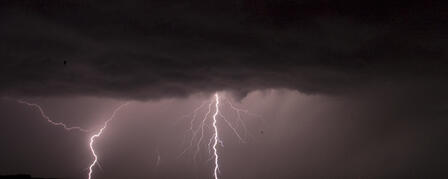OUTDOOR SAFETY TIPS FOR SEVERE WEATHER AWARENESS WEEK

March 15, 2012
Don’t let severe weather ruin the outdoor experience
TOPEKA — March 12-16 is Severe Weather Awareness Week in Kansas, a time to remind Kansas outdoorsmen and women to be prepared for stormy weather in the outdoors. Severe weather can strike quickly in the Sunflower State, and hunters, anglers, and boaters need to know how to avoid the high winds, lightning, and floods that can accompany these storms.
“The first rule of thumb for any outing is to check the weather,” says Mike Miller, Information Production Section chief for the Kansas Department of Wildlife, Parks and Tourism (KDWPT). “If storms are predicted for your area, postpone your trip. Secondly, tell someone where you are going and when you plan to return. Too often, people get caught in bad weather, even in springtime, and no one knows where to look for them. Just telling someone where you’re going could save your life.”
Blizzard
It may be above 80 degrees during Severe Weather Week this year, but such is not always the case, and blizzards are still possible this year. Some of the state’s worst blizzards occur in March. Turkey hunters, hikers, and bikers should prepare for this and wear plenty of layers if there’s the slightest chance of a winter storm. Have plenty of food and water in your vehicle. A well-charged cell phone can be a lifesaver, if you’re in an area with service. The best advice, however, is to follow the first two rules of thumb. And watch the skies; if a storm appears to be brewing, head for home.
Lightning
Again, watch the skies, especially for towering black cumulonimbus clouds. Get indoors at the first sign of these powerful storms. Remember that shotguns are lightning rods. So are fishing rods and boats on open water. And so are humans. If caught in a sudden thunderstorm, seek shelter in a vehicle or building. Boaters should get off the water, by the shortest possible route. Everyone should seek shelter immediately and avoid towering structures and isolated trees. If your skin tingles or your hair stands on the end, a lightning strike may be about to happen. Crouch down on the balls of your feet with your feet close together. Keep your hands on your knees and lower your head. Get as low as possible without touching your hands or knees to the ground. Do not lie down.
Wind
Most Kansans are well aware of the damage wrought by severe winds and tornadoes, and these events can hit without warning. Sheer straight winds of more than 100 mph are not uncommon, and tornadoes often hit in the middle of a downpour so severe that the twister itself cannot be seen. Use a smart phone to keep track of weather forecasts and radar maps. Winds can be particularly dangerous for boaters, especially on large lakes. Watch the skies for approaching storm fronts and head for shore at the first sign of severe winds.
In 2011, the National Weather Service reported about 68 tornadoes statewide, and this serves as a reminder that severe weather can strike anywhere this tornado season. Many people do not understand the difference between a storm watch and a warning. When conditions are favorable for severe weather, a severe thunderstorm or a tornado “watch” is issued. Information from weather radar, spotters, and other sources is used to issue severe thunderstorm and tornado “warnings” for areas where severe weather is imminent. Severe weather warnings are passed to local radio and television stations and broadcast over weather alert radios. These warnings are also relayed to local emergency management and public safety officials who then activate the local warning systems to alert communities.
General information about severe weather and being prepared is available at www.ready.gov.
-30-







